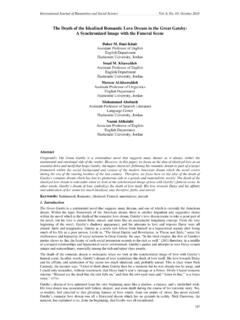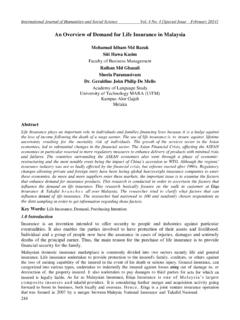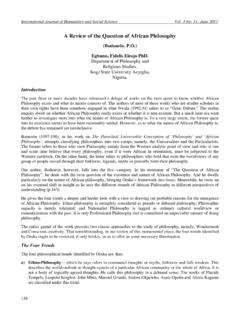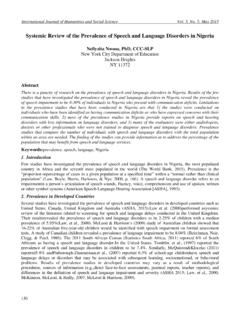Transcription of Factors Affecting Provision of Service Quality in the ...
1 International Journal of Humanities and Social Science Vol. 2 No. 13; July 2012 114 Factors Affecting Provision of Service Quality in the Public Health Sector: A Case of Kenyatta National Hospital Dr. Kenneth N. Wanjau Beth Wangari Muiruri Eunice Ayodo Jomo Kenyatta University of Agriculture & Technology P O Box 62000-00200 Nairobi, Kenya Abstract Purpose This paper seeks to explore the Factors Affecting Provision of Service Quality in the public health sector in Kenya, focusing on employee capability, technology, communication and financial resources. The paper reviews existing literature and experiences on public health Service Provision and Quality management.
2 Design/methodology/approach The paper reports on empirical evidence drawn from a case study of Kenyatta National Hospital the largest referral hospital in Eastern & Central Africa. A total of one hundred and three respondents, comprising; sixteen doctors, thirty two nurses, twenty nine clinical officers, fourteen laboratory technologists and twelve pharmacists. Data was collected using closed and open ended questionnaires. Findings: Low employee s capacity led to a decrease in Provision of Service Quality public health sector by factor of with while Inadequate Technology adoption in Provision of health Service led to a decrease in Provision of Service Quality by a factor of The Ineffective communication channels affected delivery Service Quality in public health sector by a factor of while insufficient financial resources resulted to decrease in Provision of health Service Quality by factor of This implied that low employees capacity, low technology adoption.
3 Ineffective communication channels and insufficient fund affect delivery of Service Quality to patients in public health sector Affecting health Service Quality perceptions, patient satisfaction and loyalty. Practical Implications In the paper the implications for policy include: comprehensive healthcare policy, addressing the plight of the worker, the working environment, the resources to enable the healthcare personnel perform effectively, and emotional intelligence management of the workforce. Originality/value- The paper shows that the respondents in this study were various professionals in the healthcare Provision , covering the comprehensive process of healthcare Provision from diagnosis to treatment.
4 The approach to study the largest referral hospital in Eastern and Central Africa region and data collected is indicative of special case of Kenyatta National hospital and may be entirely different from other public health institutions within the Eastern and Central Africa region. Key Words: Service , Quality , Management, Technology, Introduction Delivering Service Quality has significant relationship with customer satisfaction (Swanson and Davis, 2003), customer retention (Yavas, Benkenstein and Stuhldreier, 2004), loyalty (Boshoff and Gray, 2004), costs (Wilson 2008), profitability (Irving and Dickson, 2004), Service guarantees (Kandampully and Butler, 2001) and growth of organization (Sohail, 2003).
5 However, the poor state of customer Service in some public hospitals in Kenya has resulted in high turnover and weak morale among staff, making it difficulty to guarantee 24-hour coverage resulting in, problems with patients care, increased cost of operations due to inefficiencies (Owino and Korir, 1997) leading some patients to look for an alternative provider and to spread negative word of mouth which affects potential clients hence growth of the hospital (Tam, 2005). This situation is further worsened by the patients or customers perception of functional issues which they perceive and interact with during the course of seeking treatment such as physical facilities, internal process; interactions with doctors, nurses and other support staff as poor and unresponsive (Boshoff and Gray, 2004; Alg lanan hizmet and Connor , 2003).
6 In their studies, Demirel, Yoldas and Divanoglu (2009) found a positive and significant relationship between customers perception of Service Quality and their willingness to recommend the company. Centre for Promoting Ideas, USA 115 Whereas there has been an attempt to improve the situation (RoK, 2010) it seems not much has been achieved in raising the Quality of Service in public health institutions and this is compounded by limited information on the Factors that ail the delivery of Service Quality in the public health sector in Kenya. Local studies done on Service Quality had focussed on banking and public sector in general.
7 For instance, Gachie (2008) investigated an evaluation of Service Quality focusing on Kenyan Commercial Banks, Momanyi, (2008) carried out a Survey of Service Quality Management Initiatives In the Public Sector focusing on case study of selected ministries in Kenya while Wambugu (2009) undertook a study on the influence of Service Quality on consumer preference in petroleum retailing in Thika District. There was no known study that had focusing on investigating on factor Affecting Service Quality in public health sector. This study therefore sought to investigate Factors Affecting Provision of Service Quality in public health sector in Kenya with specific reference to Kenyatta National Hospital.
8 Literature Review Health Sector in Kenya Quality as defined by International Organization for Standardization is a relative concept and if the inherent characteristic of a Service meets the requirements of the customer, it can be rated as high Quality (Reinartz, 2004). In a Service industry, like healthcare, experience of the patient plays a crucial role in rating and assessment of Quality of services . Quality in healthcare may comprise of newer technology, newer and effective medication, and higher staff to patient ratios, affordability, efficiency and effectiveness of Service delivery (Tam, 2005). The health sector comprises the public system with major players including the Ministry of Health and parastatals organizations, and the private sector, which includes private for-profit, Non Governmental Organizations, and Faith Based Organizations facilities (RoK, 2010).
9 In healthcare industry Service Quality has become an imperative (Ennis and Harrington, 2001) in providing patient satisfaction because delivering Quality Service directly affects the customer satisfaction, loyalty and financial profitability of Service businesses. In healthcare, Service Quality can be broken down into two Quality dimensions: technical Quality and functional Quality (Dean and Lang, 2008). While technical Quality in the health care sector is defined primarily on the basis of the technical accuracy of the medical diagnoses and procedures or the conformance to professional specifications, functional Quality refers to the manner in which the health care Service is delivered to the patients.
10 In Kenya, Health services are provided through a network of over 4,700 health facilities countrywide, with the public sector system accounting for about 51 percent of these facilities. The public health sector consists of the following levels of health facilities: national referral hospitals, provincial general hospitals, district hospitals, health centres, and dispensaries. Health services are integrated as one goes down the hierarchy of health structure from the national level to the provincial and district levels (RoK, 2011). The two national referral hospitals are Kenyatta National Hospital in Nairobi and Moi Referral and Teaching Hospital in Eldoret.















